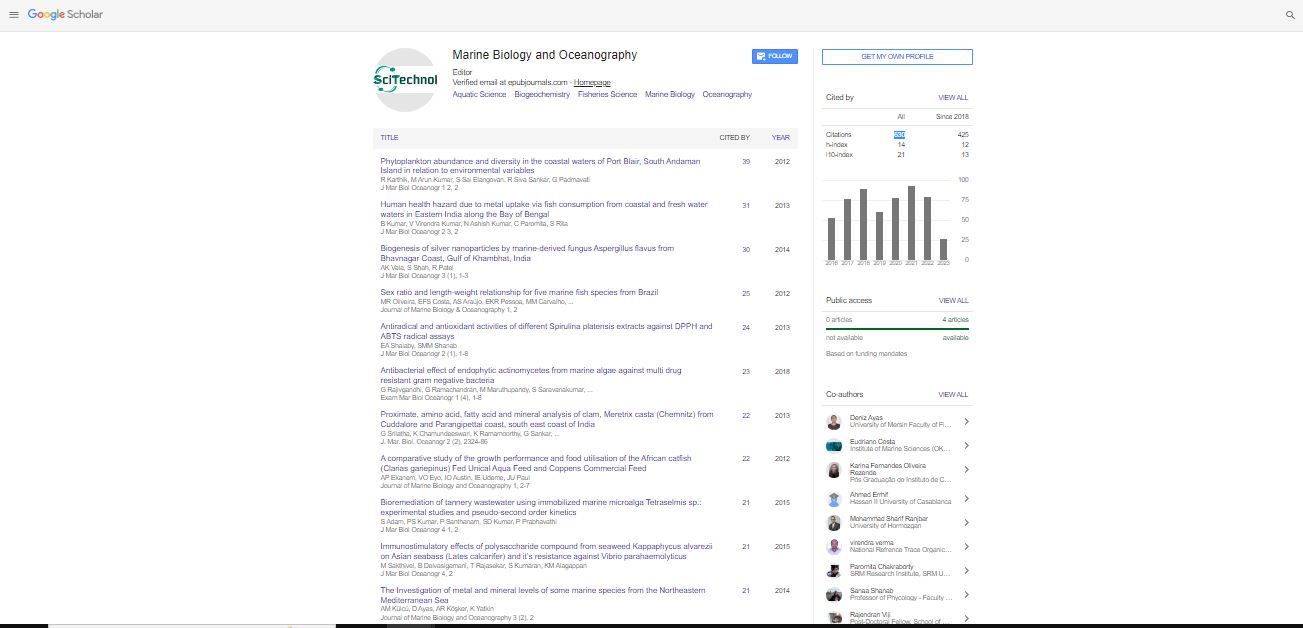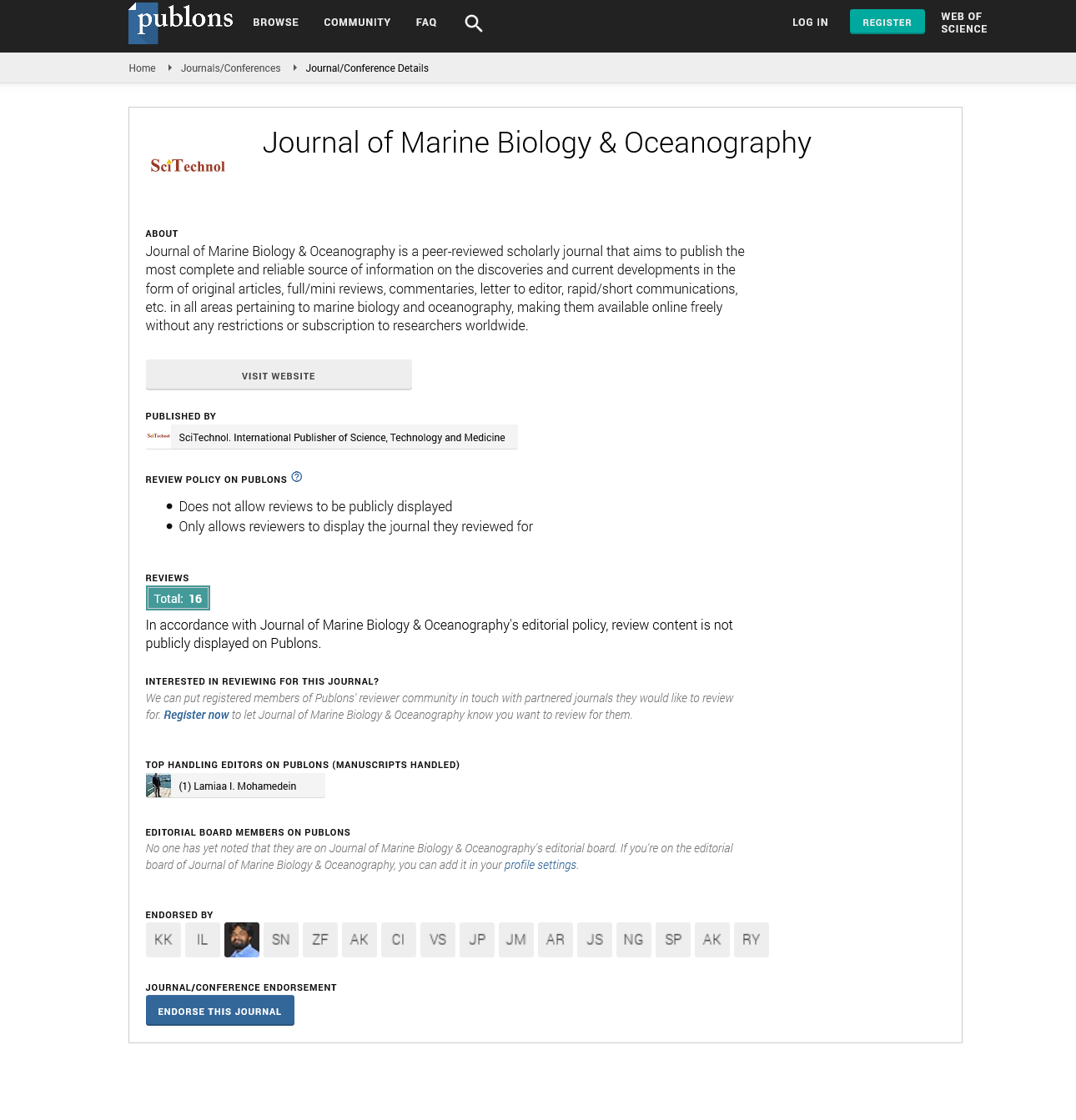Perspective, J Mar Biol Oceanogr Vol: 11 Issue: 5
Marine Chemistry Variation Indicated By Chemical Fingerprints
Jingzhen Hu*
Department of Mathematics, Duke University, Durham, USA
*Corresponding author: Jingzhen Hu
Department of Mathematics, Duke University, Durham, USA
Email: jingzhenh56@gmail.com
Received date: 18 April, 2022; Manuscript No. JMBO-22-52522;
Editor assigned date: 20 April, 2022; PreQC No. JMBO-22-52522 (PQ);
Reviewed date: 29 April, 2022; QC No. JMBO-22-52522;
Revised date: 09 May, 2022; Manuscript No. JMBO-22-52522 (R);
Published date: 19 May, 2022; DOI: 10.4172/2324-8661.1000242
Citation: Hu J (2022) Marine Chemistry Variation Indicated By Chemical Fingerprints. J Mar Biol Oceanogr 11:5.
Keywords: Marine Chemistry
Description
Many methodologies are utilized to fix skeletal imperfections in reconstructive muscular medical procedure, and bone joining is associated with for all intents and purposes each methodology. The sort of bone join utilized relies upon the clinical situation and the expected ultimate result. Autogenous cancellous bone join, with its osteogenic, osteoinductive, and osteoconductive properties, stays the norm for uniting. Notwithstanding, the high occurrence of bleakness during autogenous unite gather might make the procurement of unions from different sources alluring. The clinical applications for each sort of bone unite are directed by the design and biochemical properties of the join. An exquisite cell and sub-atomic course follows bone transplantation. Bone join consolidation inside the host, whether autogenous or allogeneic, relies upon many elements: kind of unite (autogenous versus allogeneic, vascular versus nonvascular), site of relocate, nature of relocated bone and host bone, have bed readiness, protection procedures, fundamental and neighborhood illness, and mechanical properties of the unite. This article surveys nanocomposites zeroing in on their effect and ongoing patterns in the field of bone joining. Albeit autogenous-and allogeneic-bone unions have been utilized for quite a while in bone treatments, there is as yet a giver lack and disease risk. As another option, manufactured biomaterials have been created and clinically utilized as bone unions, yet the vast majority of them contrast considerably from normal bone either compositionally or basically. It stays an extraordinary test to plan an ideal bone join that imitates nature's own design. Inferable from the organization and underlying closeness to regular bone, a large portion of the ebb and flow examinations include the utilization of nanocomposites, especially hydroxyapatite/collagen framework, as promising bone unions, yet it is amazing that none of the reports survey the reasoning and plan system of such nanocomposites exhaustively to support analysts. In like manner, this article tends to the best in class of those nanocomposites and gives ideas to future innovative work. This survey gives an outline of the nanocomposite system of bone, bone joining, manufactured ways to deal with bone design, improvement of nanocomposites from the ordinary solid biomaterials, and as of late evolved handling conditions for making nanocomposites. The audit is supposed to be helpful for perusers to acquire an in-sight on the cutting edge of nanocomposites as another class of manufactured bone unions.
Bone unions in clinical practice are fundamentally used to assist with accomplishing hard association in instances of sluggish recuperating of breaks or pseudoarthrosis; to enhance the mending of specific new cracks; to advance combination (arthrodesis) of joints harmed by injury, illness, or distortion, and to fill deserts in bone made by growths, ongoing contamination, or injury. This article thinks about the sorts and elements of bone unions. There are three classes of bonejoining materials in light of the method of activity. Autogenous bone is a natural material and structures bone by osteogenesis, osteoinduction, and osteoconduction. Allografts, for example, demineralized freezedried bone are osteoinductive and osteoconductive and might be cortical or potentially trabecular in nature. Alloplasts, for example, hydroxyapatite and tricalcium phosphate might be engineered or normal, fluctuate in size, and are just osteoconductive. They can be isolated into three sorts in view of the porosity of the item and incorporate thick, macroporous, and microporous materials. Furthermore, alloplastic materials might be translucent or shapeless. These materials have various properties and consequently signs. The utilization of the three classes of materials in assorted blends relies on the size and geography of the hard imperfection. Little deformities or imperfections with four dividers of host bone can be fixed with alloplasts alone or allografts in blend with alloplasts. The deficiency of at least three hard dividers orders the expansion of autogenously issue that remains to be worked out unite or the utilization of a little pore layer. The bigger the deformity, the more autogenously bone is required. The various signs of bone substitutes are examined with respect to their particular applications in embed dentistry. As the populace ages, the quantity of activities performed on bone is supposed to increment. Infections like joint inflammation, cancers, and injury can prompt deformities in the skeleton requiring an activity to supplant or reestablish the lost bone. Specialists can utilize autografts, allografts, and additionally bone unites substitutes to reestablish areas of bone misfortune. Careful inserts are additionally utilized moreover or in confinement to supplant the ailing bone. This survey thinks about the use of accessible bone unions in various clinical settings. It likewise examines as of late presented bioactive biomaterials and features the clinical challenges and mechanical inadequacies that exist in our present careful practice. Bone joining is utilized to increase bone mending and give soundness after spinal medical procedure. Autologous bone unite is restricted in amount and sadly connected with expanded careful time and contributor site horribleness. Choices to bone joining in spinal medical procedure incorporate the utilization of allografts, osteoinductive development factors, for example, bone morphogenetic proteins and different engineered osteoconductive transporters.
Coastal Geography
Late examination has given understanding into techniques that might tweak the bone recuperating process at the cell level as well as switching the impacts of suggestive plate degeneration, which is a possibly handicapping condition, oversaw regularly with different combination strategies. With numerous aides and choices accessible for use in spinal medical procedure, a brief audit of the present bone it is important to unite options in spinal medical procedure. Options in contrast to autologous bone unite incorporate allograft bone, demineralized bone lattice, recombinant development variables and engineered inserts. Every one of these choices might actually be joined with autologous bone marrow or different development factors. Albeit none of the as of now accessible substitutes gives each of the three of the central properties of auto graft bone (osteogenicity, osteoconductivity and osteoinductivity), there are various circumstances in which they have demonstrated clinically helpful. Options in contrast to autogenous bone joining observe their most noteworthy allure when autograft bone is restricted in supply or when adequate paces of combination might be accomplished with these substitutes (or extenders) in spite of the shortfall of at least one of the properties of autologous bone unite. In these clinical circumstances, the horribleness of auto graft gather is sensibly stayed away from. Future examination might find that mixes of materials may aggregately bring about the statement of osteogenesis, osteoinductivity and osteoconductivity found in autogenously sources.
 Spanish
Spanish  Chinese
Chinese  Russian
Russian  German
German  French
French  Japanese
Japanese  Portuguese
Portuguese  Hindi
Hindi 
